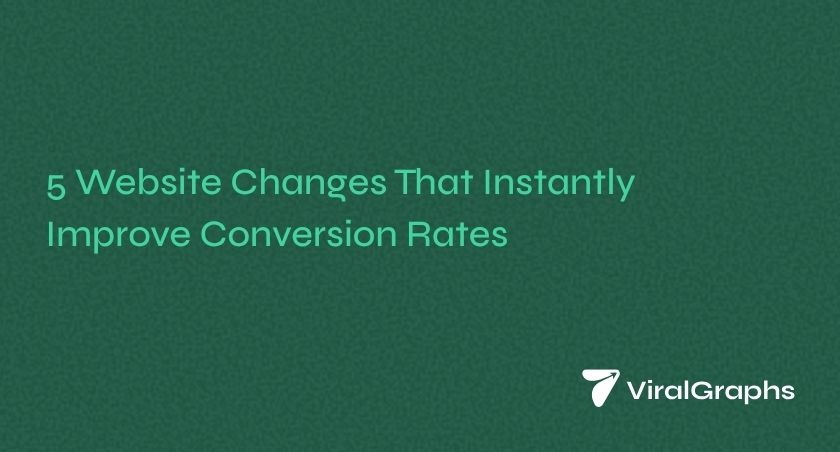Your website is your digital storefront. Whether you’re running an e-commerce store, a SaaS company, or a blog, your website’s conversion rate is the ultimate metric that determines the success of your online efforts. Simply attracting traffic is no longer enough conversions are what drive your revenue and growth.
In 2025, the online marketplace will be more competitive than ever, and marketers are continually seeking ways to enhance conversion rates. While attracting more traffic through SEO and PPC is vital, optimizing your website to turn that traffic into leads, sales, or subscribers is what truly drives business growth.
This article highlights five website changes you can make today to improve your conversion rates instantly. These actionable strategies encompass the most crucial elements of website conversion optimization (WCO), including user experience (UX), page load speed, call-to-action (CTA) effectiveness, and mobile responsiveness. By implementing these changes, you’ll see immediate improvements in conversion rates, which directly impact your bottom line.
Let’s dive into these changes and explore how you can start boosting your website performance now.
Understanding Conversion Rates and Why They Matter
What is Conversion Rate Optimization (CRO)?
Conversion rate optimization (CRO) is the process of improving the effectiveness of your website to convert visitors into customers, leads, or other desired actions. Conversion rates are typically calculated by dividing the number of conversions by the total number of visitors.
In simple terms, it’s about enhancing your website’s user experience to ensure that visitors are more likely to take action, whether that means purchasing a product, filling out a contact form, or subscribing to a newsletter.
Why Conversion Rates Are Key to Business Growth
In the digital age, conversion rates are directly tied to business growth. With increasing marketing costs and competition, improving your conversion rate is one of the most cost-effective ways to boost revenue without having to attract additional traffic.
- Higher ROI: By improving conversion rates, you’re maximizing the value of the traffic you already have.
- Better Customer Journeys: A high conversion rate often indicates that your website offers a seamless and engaging experience for users.
- Cost-Effective Marketing: Improving conversions is typically more affordable than investing heavily in traffic acquisition.
For businesses looking to grow and scale, optimizing your website to drive higher conversion rates is a non-negotiable requirement. The following website changes will help you unlock that potential.
5 Website Changes That Instantly Improve Conversion Rates
1. Simplify Your Website Navigation for a Seamless Experience
Your website’s navigation plays a critical role in how easily users can find what they’re looking for. If your navigation is confusing or overwhelming, users will bounce—resulting in lost conversions.
- Clear Menus: Use simple, straightforward menus that help users easily navigate through your site. Avoid clutter and minimize the number of clicks required to reach key pages.
- Intuitive User Flow: Ensure that users can easily access the most critical information, such as product details, pricing, or contact forms, without requiring unnecessary clicks.
- Mobile Navigation: Ensure that your website navigation is mobile-friendly. With over 60% of web traffic coming from mobile devices, this is essential.
2. Optimize Landing Pages for Maximum Impact
Landing pages are where the magic happens. Whether it’s a product page, a lead-generation form, or a special offer, landing pages are designed to convert visitors into leads or customers.
Key elements to optimize:
- Clear, Compelling Headlines: Your headline should immediately communicate the value of what you’re offering.
- Effective CTAs: Calls-to-action should be action-oriented and stand out on the page. Use contrasting colors and clear, actionable language, and ensure the CTA button is easily visible.
- Streamlined Forms: Keep forms concise and straightforward to minimize visitor frustration. Only ask for essential information.
3. Speed Up Your Website’s Load Time
Website speed is one of the most crucial factors affecting conversion rates. A slow-loading website can lead to high bounce rates and frustrated visitors.
- Compress Images: Utilize image formats such as WebP or JPEG 2000 to reduce file size without compromising quality.
- Leverage Browser Caching: Set up caching to prevent users from having to reload resources every time they visit the site, thereby improving site performance.
- Minimize HTTP Requests: Reduce the number of elements (such as images and scripts) on your page that require HTTP requests to minimize the total number of requests.
Studies show that every 1-second delay in load time can lead to a 7% drop in conversions. Ensuring your website loads in under 3 seconds is critical for higher conversion rates.
4. Use Persuasive CTAs (Call-to-Actions)
Your CTAs are the driving force behind your conversions. Without clear, compelling calls to action, users won’t know what to do next.
- Action-Oriented Language: Use action verbs that create urgency, such as “Get Started,” “Claim Your Offer,” or “Book a Demo.”
- Eye-Catching Design: Ensure your CTAs are visually distinct by using contrasting colors, larger fonts, or buttons that stand out from the rest.
- Strategic Placement: Place CTAs at key moments during the user journey—above the fold, at the end of blog posts, and after key content sections.
5. Make Your Website Mobile-Friendly
With mobile-first indexing and over 60% of web traffic coming from mobile devices, having a mobile-optimized website is non-negotiable.
- Responsive Design: Your website should automatically adjust to fit any screen size, ensuring a seamless experience for mobile users.
- Touch-Friendly Elements: Buttons and links should be large enough to be clicked easily on mobile devices.
Fast Load Time on Mobile: Mobile users are often on the go, so ensuring your mobile website loads quickly is critical for conversions.
Measuring the Impact of Website Changes on Conversion Rates
Key Metrics to Track
To determine the effectiveness of your website optimizations, track the following KPIs:
- Conversion Rate: The percentage of visitors who complete the desired action (form submissions, purchases, etc.).
- Bounce Rate: A high bounce rate could indicate issues with user experience or irrelevant content.
- Engagement Metrics: Track how long users stay on your site and the number of pages they visit.
A/B Testing for Blog Content
A/B testing allows you to test different versions of your website elements (e.g., CTAs, landing pages, images) to determine which version converts best.
- Test Headlines, CTAs, and Forms: Run A/B tests on key elements to see what works best for your audience.
- Use Data to Refine Your Strategy: After running A/B tests, utilize the results to refine and continually optimize your website for improved conversions.
Real-Life Examples: How Small Changes Made Big Differences
Case Study 1: E-commerce Website
A leading e-commerce brand streamlined its checkout process, reduced unnecessary steps, and simplified the payment page. As a result, they saw a 25% increase in conversions and a 30% drop in cart abandonment.
Case Study 2: SaaS Company
A SaaS provider optimized its landing pages, made the CTA buttons more prominent, and tested different headlines. This resulted in a 50% increase in trial sign-ups and a higher conversion rate for product demos.
Conclusion & CTA
Improving your conversion rate is one of the most impactful ways to grow your business in 2025. The website changes we’ve discussed—from simplifying navigation to optimizing CTAs and improving load speed—are easy to implement yet highly effective at boosting conversions.
By focusing on these five areas, you can enhance your website user experience, increase engagement, and see tangible improvements in your conversion rates.
Ready to optimize your website for higher conversions? Connect with ViralGraphs to learn how expert conversion optimization strategies can help you achieve better results and accelerate your business growth.



